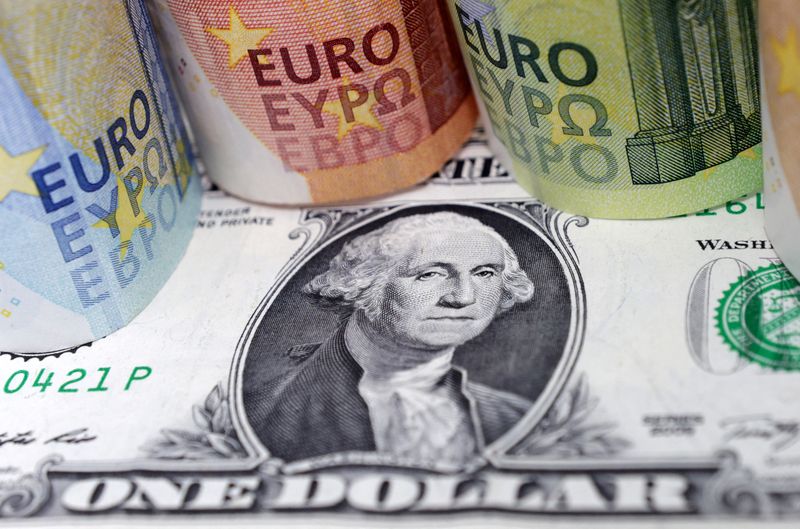By Alun John and Samuel Indyk
LONDON (Reuters) -The dollar rose slightly on Thursday after Federal Reserve Chair Jerome Powell pushed back against bets of early U.S. rate cuts, while sterling cut losses after the Bank of England said it would need more evidence of slowing inflation before easing.
Meanwhile, the euro fell to a seven-week low while the yen and Swiss franc were steady as traders processed market jitters about U.S. regional lenders.
That left the U.S. dollar index - which measures the currency against a basket of six major peers including the euro, yen and British pound - slightly higher at 103.63.
It remains close to the recent high of 103.82 touched on Monday of this week and Tuesday of last week, and previously not seen since Dec. 13.
The dollar has been buoyed by U.S. economic data suggesting the Fed can wait longer before cutting interest rates, and Powell gave the currency another push overnight by calling a cut in March "not the base case".
"I don't think it's likely the committee will reach a level of confidence by the time of the March meeting" to ease policy, "but that's to be seen", Powell said at a press conference after Fed officials left rates unchanged but dropped a longstanding reference to possible further hikes in borrowing costs.
"The objectives were not to feed March rate cut expectations and keep the (rate setting) Federal Open Market Committee's options open, and I think they've done both of those very well," said Derek Halpenny, head of research global markets EMEA at MUFG.
The Fed outcome sent U.S. Treasury yields lower, reinforcing a rush to bonds driven by renewed jitters over regional U.S. banks after New York Community Bancorp crashed 37% on Wednesday to the lowest in more than two decades after posting a surprise loss. [MKTS/GLOB]
The two-year U.S. Treasury yield shed 13 basis points on Wednesday, although it was up 2 bps on Thursday at 4.24%. [US/]
The dollar touched a two-week intraday low at 146.005 yen on Wednesday, but was last little changed at 146.96.
"Dollar yen wouldn't be where it is without what's happening (with U.S. regional banks)," said Halpenny.
"If markets regard the knee-jerk response to the regional bank news as an over-reaction, then the less dovish FOMC will be the key story in coming days, supporting the U.S. dollar," said Sean Callow, a foreign-exchange strategist at Westpac.
The pound cut earlier losses and was last down 0.1% against the dollar at $1.2670 after the Bank of England reiterated that policy would need to stay "restrictive for sufficiently long", while two policymakers voted to raise rates, pouring cold water on expectations for early interest rate cuts.
However, Swati Dhingra voted to cut interest rates - the first time since August 2008, early in the global financial crisis, that different policymakers have voted to move interest rates up and down at the same meeting.
"While the ECB and the Fed are hinting at rate cuts, the Bank of England's reticence for these discussions continues to make it stand out as an outlier," said Kyle Chapman, FX market analyst at Ballinger & Co.
"The most interesting point for us is the expectation that inflation will soon temporarily reach the 2% target before reaccelerating - this suggests that a sharp fall in inflation in the near-term may be less impactful on policy than we would have thought previously."

The other rate decision on Thursday was from Sweden's Riksbank, which kept its key interest rate unchanged at 4.00% as expected. But the bank said that if inflation continued to slow it might be able to bring forward the timing of a first rate cut, possibly even to the first half of 2024.
Sweden's crown weakened after the decision and the euro was last up 0.7% at 11.323 crowns.